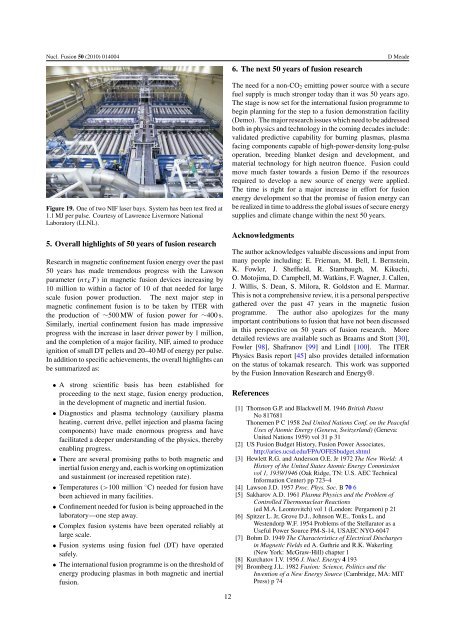50 years of fusion research - Princeton Plasma Physics Laboratory
50 years of fusion research - Princeton Plasma Physics Laboratory
50 years of fusion research - Princeton Plasma Physics Laboratory
Create successful ePaper yourself
Turn your PDF publications into a flip-book with our unique Google optimized e-Paper software.
Nucl. Fusion <strong>50</strong> (2010) 014004 D Meade<br />
Figure 19. One <strong>of</strong> two NIF laser bays. System has been test fired at<br />
1.1 MJ per pulse. Courtesy <strong>of</strong> Lawrence Livermore National<br />
<strong>Laboratory</strong> (LLNL).<br />
5. Overall highlights <strong>of</strong> <strong>50</strong> <strong>years</strong> <strong>of</strong> <strong>fusion</strong> <strong>research</strong><br />
Research in magnetic confinement <strong>fusion</strong> energy over the past<br />
<strong>50</strong> <strong>years</strong> has made tremendous progress with the Lawson<br />
parameter (nτET) in magnetic <strong>fusion</strong> devices increasing by<br />
10 million to within a factor <strong>of</strong> 10 <strong>of</strong> that needed for large<br />
scale <strong>fusion</strong> power production. The next major step in<br />
magnetic confinement <strong>fusion</strong> is to be taken by ITER with<br />
the production <strong>of</strong> ∼<strong>50</strong>0 MW <strong>of</strong> <strong>fusion</strong> power for ∼400 s.<br />
Similarly, inertial confinement <strong>fusion</strong> has made impressive<br />
progress with the increase in laser driver power by 1 million,<br />
and the completion <strong>of</strong> a major facility, NIF, aimed to produce<br />
ignition <strong>of</strong> small DT pellets and 20–40 MJ <strong>of</strong> energy per pulse.<br />
In addition to specific achievements, the overall highlights can<br />
be summarized as:<br />
• A strong scientific basis has been established for<br />
proceeding to the next stage, <strong>fusion</strong> energy production,<br />
in the development <strong>of</strong> magnetic and inertial <strong>fusion</strong>.<br />
• Diagnostics and plasma technology (auxiliary plasma<br />
heating, current drive, pellet injection and plasma facing<br />
components) have made enormous progress and have<br />
facilitated a deeper understanding <strong>of</strong> the physics, thereby<br />
enabling progress.<br />
• There are several promising paths to both magnetic and<br />
inertial <strong>fusion</strong> energy and, each is working on optimization<br />
and sustainment (or increased repetition rate).<br />
• Temperatures (>100 million ◦ C) needed for <strong>fusion</strong> have<br />
been achieved in many facilities.<br />
• Confinement needed for <strong>fusion</strong> is being approached in the<br />
laboratory—one step away.<br />
• Complex <strong>fusion</strong> systems have been operated reliably at<br />
large scale.<br />
• Fusion systems using <strong>fusion</strong> fuel (DT) have operated<br />
safely.<br />
• The international <strong>fusion</strong> programme is on the threshold <strong>of</strong><br />
energy producing plasmas in both magnetic and inertial<br />
<strong>fusion</strong>.<br />
12<br />
6. The next <strong>50</strong> <strong>years</strong> <strong>of</strong> <strong>fusion</strong> <strong>research</strong><br />
The need for a non-CO2 emitting power source with a secure<br />
fuel supply is much stronger today than it was <strong>50</strong> <strong>years</strong> ago.<br />
The stage is now set for the international <strong>fusion</strong> programme to<br />
begin planning for the step to a <strong>fusion</strong> demonstration facility<br />
(Demo). The major <strong>research</strong> issues which need to be addressed<br />
both in physics and technology in the coming decades include:<br />
validated predictive capability for burning plasmas, plasma<br />
facing components capable <strong>of</strong> high-power-density long-pulse<br />
operation, breeding blanket design and development, and<br />
material technology for high neutron fluence. Fusion could<br />
move much faster towards a <strong>fusion</strong> Demo if the resources<br />
required to develop a new source <strong>of</strong> energy were applied.<br />
The time is right for a major increase in effort for <strong>fusion</strong><br />
energy development so that the promise <strong>of</strong> <strong>fusion</strong> energy can<br />
be realized in time to address the global issues <strong>of</strong> secure energy<br />
supplies and climate change within the next <strong>50</strong> <strong>years</strong>.<br />
Acknowledgments<br />
The author acknowledges valuable discussions and input from<br />
many people including: E. Frieman, M. Bell, I. Bernstein,<br />
K. Fowler, J. Sheffield, R. Stambaugh, M. Kikuchi,<br />
O. Motojima, D. Campbell, M. Watkins, F. Wagner, J. Callen,<br />
J. Willis, S. Dean, S. Milora, R. Goldston and E. Marmar.<br />
This is not a comprehensive review, it is a personal perspective<br />
gathered over the past 47 <strong>years</strong> in the magnetic <strong>fusion</strong><br />
programme. The author also apologizes for the many<br />
important contributions to <strong>fusion</strong> that have not been discussed<br />
in this perspective on <strong>50</strong> <strong>years</strong> <strong>of</strong> <strong>fusion</strong> <strong>research</strong>. More<br />
detailed reviews are available such as Braams and Stott [30],<br />
Fowler [98], Shafranov [99] and Lindl [100]. The ITER<br />
<strong>Physics</strong> Basis report [45] also provides detailed information<br />
on the status <strong>of</strong> tokamak <strong>research</strong>. This work was supported<br />
by the Fusion Innovation Research and Energy®.<br />
References<br />
[1] Thomson G.P. and Blackwell M. 1946 British Patent<br />
No 817681<br />
Thonemen P C 1958 2nd United Nations Conf. on the Peaceful<br />
Uses <strong>of</strong> Atomic Energy (Geneva, Switzerland) (Geneva:<br />
United Nations 1959) vol 31 p 31<br />
[2] US Fusion Budget History, Fusion Power Associates,<br />
http://aries.ucsd.edu/FPA/OFESbudget.shtml<br />
[3] Hewlett R.G. and Anderson O.E. Jr 1972 The New World: A<br />
History <strong>of</strong> the United States Atomic Energy Commission<br />
vol 1, 1939/1946 (Oak Ridge, TN: U.S. AEC Technical<br />
Information Center) pp 723–4<br />
[4] Lawson J.D. 1957 Proc. Phys. Soc. B 70 6<br />
[5] Sakharov A.D. 1961 <strong>Plasma</strong> <strong>Physics</strong> and the Problem <strong>of</strong><br />
Controlled Thermonuclear Reactions<br />
(ed M.A. Leontovitch) vol 1 (London: Pergamon) p 21<br />
[6] Spitzer L. Jr, Grove D.J., Johnson W.E., Tonks L. and<br />
Westendorp W.F. 1954 Problems <strong>of</strong> the Stellarator as a<br />
Useful Power Source PM-S-14, USAEC NYO-6047<br />
[7] Bohm D. 1949 The Characteristics <strong>of</strong> Electrical Discharges<br />
in Magnetic Fields ed A. Guthrie and R.K. Wakerling<br />
(New York: McGraw-Hill) chapter 1<br />
[8] Kurchatov I.V. 1956 J. Nucl. Energy 4 193<br />
[9] Bromberg J.L. 1982 Fusion: Science, Politics and the<br />
Invention <strong>of</strong> a New Energy Source (Cambridge, MA: MIT<br />
Press) p 74
















